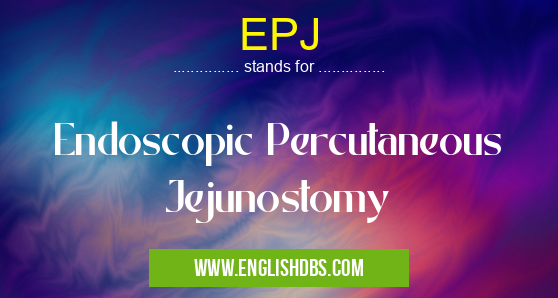What does EPJ mean in UNCLASSIFIED
EPJ is an abbreviation for Endoscopic Percutaneous Jejunostomy. It is a medical procedure that involves inserting a feeding tube into the jejunum, the middle part of the small intestine, through the abdominal wall. This procedure is typically performed on patients who are unable to eat or drink due to certain medical conditions, such as cancer or severe malnutrition.

EPJ meaning in Unclassified in Miscellaneous
EPJ mostly used in an acronym Unclassified in Category Miscellaneous that means Endoscopic Percutaneous Jejunostomy
Shorthand: EPJ,
Full Form: Endoscopic Percutaneous Jejunostomy
For more information of "Endoscopic Percutaneous Jejunostomy", see the section below.
EPJ Procedure
The EPJ procedure is performed under general anesthesia or conscious sedation. A small incision is made in the abdomen, and a guidewire is passed through the incision and into the jejunum. The feeding tube is then passed over the guidewire and secured in place.
Benefits of EPJ
EPJ offers a number of benefits for patients who are unable to eat or drink, including:
- Provides nutrition and hydration directly to the small intestine
- Helps to maintain a healthy weight
- Improves tolerance to chemotherapy and radiation therapy
- Reduces the risk of hospitalization and complications
Risks of EPJ
Like any medical procedure, EPJ carries some potential risks, including:
- Bleeding
- Infection
- Leakage around the feeding tube
- Peritonitis
Essential Questions and Answers on Endoscopic Percutaneous Jejunostomy in "MISCELLANEOUS»UNFILED"
What is an EPJ (Endoscopic Percutaneous Jejunostomy)?
An EPJ is a surgical procedure that creates an opening (stoma) in the small intestine (jejunum) through the abdominal wall. A feeding tube is then inserted through the stoma to provide nutrition and hydration directly into the jejunum.
Why is an EPJ performed?
An EPJ may be performed when a person is unable to eat or drink normally due to conditions such as:
- Obstruction of the esophagus or stomach
- Inability to swallow due to neurological disorders
- Severe malnutrition
How is an EPJ procedure performed?
An EPJ procedure typically involves the following steps:
- Inserting an endoscope (a thin, flexible tube with a camera) into the mouth and down the esophagus
- Using the endoscope to locate the jejunum and create a small opening
- Inserting a feeding tube through the opening and securing it to the abdominal wall
What are the benefits of an EPJ?
EPJ can provide the following benefits:
- Improved nutritional status
- Reduced risk of malnutrition and its complications
- Reduced nausea and vomiting
- Enhanced comfort and quality of life
Are there any risks associated with EPJ?
As with any surgical procedure, EPJ carries some risks, including:
- Infection
- Bleeding
- Leakage around the stoma
- Migration of the feeding tube
- Abdominal pain
How long does an EPJ typically remain in place?
The duration of an EPJ varies depending on the underlying medical condition. Some patients may require an EPJ for a short period (weeks to months), while others may need it long-term (years).
Final Words: EPJ is a safe and effective procedure that can provide nutrition and hydration to patients who are unable to eat or drink. It is important to discuss the benefits and risks of EPJ with your doctor before making a decision about whether or not to have the procedure.
